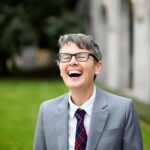In March 1993, a group of twenty-two Western Buddhist teachers representing different lineages met with His Holiness the Dalai Lama in Dharamsala, India, to discuss the transmission and adaptation of Buddhism to the West. One of their central topics was ethical teacher conduct. Participants reflected on differences between seeing the teacher as a living buddha and as a human spiritual friend, hierarchical and democratic models of authority, and Tibetan monastic versus American lay teacher trainings.
This conversation was prompted by several high-profile cases of sexual abuse and ethical misconduct by Asian and American teachers over the years. In 1983, for instance, married Japanese Zen teacher Maezumi Roshi, founder of the Los Angeles Zen Center, apologized for having affairs with several female students and entered treatment for alcoholism. In 1989, it was revealed that Osel Tendzin, the American dharma heir of Chögyam Trungpa, had engaged in unprotected sex with a number of his students despite knowing he was HIV positive. One student later died of AIDS, as did Tendzin.*
As American Zen priest Bodhin Kjolhede explained about the 1993 event, “Several of our presentations addressed the grave problem of ethical misconduct on the part of Buddhist teachers. Many of us, including the Dalai Lama, have grown increasingly alarmed in recent years at the abuse of alcohol, sex, power, and money by roshis, senseis, lamas, rinpoches, and tulkus as well as some teachers in the Vipassana and other Theravadan traditions.”
At the end of the conference, the teachers formed the Network of Western Buddhist Teachers and issued an “open letter” which stated that “No matter what level of spiritual attainment a teacher has, or claims to have reached, no person can stand above the norms of ethical conduct.” It encouraged students to confront and, if necessary, publicize teachers’ unethical behavior, and to acknowledge the “beneficial insights” that could be gained from non-Buddhist frameworks such as psychotherapy.
While the open letter suggested that Western teachers were at the forefront of tackling Buddhist sexual misconduct, signatories of that letter, and their students, have in the thirty years since faced sexual misconduct and abuse allegations themselves. Between 2008 and 2020, five women accused American Tibetan Buddhist teacher Lama Surya Das, one of the conference’s organizers, of sexual misconduct. Junpo Denis Kelly’s Mondo Zen community went through a crisis after he had what he described as an “affair” with a married student. In 2019, second-generation Insight teacher Noah Levine, who was trained by conference co-organizer Jack Kornfield, was found to have broken the precepts of sexual misconduct and nonharming. (Levine’s authorization to teach was withdrawn soon after.)
These sobering facts show that sexual abuse and related ethical breaches have continued across racial, generational, and lineage lines in transnational Buddhism for over four decades. How have Buddhists responded to these crises? In what ways have Western understandings of Buddhist traditions matured? Which non-Buddhist frameworks have they found helpful in addressing teacher misconduct? What new teacher models, ethical trainings, community practices, and organizational practices have they developed? What challenges remain?
The Distorting Lens of Orientalism and Idealization
The majority of American convert Buddhists first encountered Buddhism via the 1960s and ’70s counterculture, which was part of a cultural lineage that historian J. J. Clarke called “affirmative Orientalism.” Championed by Western Romantics, affirmative Orientalism presents the “mystical and transcendent” East as providing a spiritual antidote to the materially advanced but soulless West. Working within this wider Orientalist framework, both Asian and Western Buddhist modernist figures promoted an idealized model of the teacher that reflected decontextualized doctrines and religious archetypes rather than social realities.
In the case of Rinzai Zen Buddhism, for instance, the teacher is presented as an iconoclastic monk who has transcended dualistic ethical norms and may use unconventional methods to wake up his students. This draws on historical figures such as poet-monk Ikkyu Sojun (1394–1491), who found liberation by masturbating, visiting brothels, and falling madly in love with a beautiful blind singer called Shin. However, as scholar of Japanese religions Lori Meeks points out, in contemporary Japan, such examples are typically treated as rhetorical devices for understanding emptiness, and not as models of behavior for ordinary monks. It is hard to imagine that many parishioners in contemporary Japan would tolerate a local temple monk who attempted to justify unethical behavior by citing the example of a figure like Ikkyu.
American converts were generally not educated about the specific social and institutional contexts that Asian Buddhist teachers were embedded in. While these contexts are themselves marked by androcentrism and are not immune to abuses, they do provide local systems of ethical standards, restraint, and accountability. Unmoored from their regulatory systems and idealized by American students, some Asian Buddhist teachers struggled to maintain ethical integrity in the new and radically different cultural context they found themselves in. Other predatory teachers were able to take advantage of their students’ naivete and the lack of institutional oversight. Multiple accounts of Rigpa founder Sogyal Lakar (aka Sogyal Rinpoche), for instance, show that he intentionally manipulated Vajrayana Buddhist doctrine and Western students’ idealizations to abuse repeatedly without consequence.
Responses to Sexual Abuse: From Teacher Boundary Training to Board Training
The first wave of sexual misconduct and other abuses of power by Buddhist teachers in the 1980s pierced through some American Buddhists’ idealizations and forced them to encounter the reality rather than the ideal of Buddhist teachers. One early response came from Jack Kornfield, cofounder of Insight Meditation Society (IMS) and Spirit Rock Meditation Center. The IMS community was thrown into crisis after an incident involving the Burmese Indian teacher Anagarika Munindra, who came to the IMS to teach a three-month retreat in 1984. Although he held anagarika vows, which include celibacy, Munindra became sexually involved with a young woman on the retreat. This was problematic not just for the integrity of Munindra’s own vows, but also for the gathered retreatants, all of whom were expected to take and keep temporary vows of celibacy at the retreat center for the duration. Kornfield insisted that the board of IMS be informed of what he regarded as a serious ethical breach, one compounded by the fact that the young woman in question had a history of sexual abuse.
In 1985, Kornfield published an article called “Sex Lives of the Gurus” in Yoga Journal. He surveyed fifty-four spiritual teachers (Buddhist, Hindu, Jain), of whom forty-eight were men and six were women, and discovered that thirty-four had had sexual encounters with one or more of their students. While describing some of these relationships as “conscious, loving, and freely chosen,” Kornfield acknowledges that “some have involved the exploitation of the teacher–student relationship.” He continues, “Nonetheless, of the students with whom I have spoken, most of whom were women, approximately half report that such sexual relationships have undermined their practice, their relationship with their teacher, and their feelings of self-worth.”
Coming to realize that more than the traditional, Buddhist, five precepts were needed to guide teachers, Kornfield wrote a Teacher Code of Ethics for IMS that was also adopted by Spirit Rock. The Code included an expanded interpretation of the third precept against sexual misconduct that condemned teachers using “their teaching role to exploit their authority and position in order to assume a sexual relationship with a student.” It also proposed that a genuine and committed relationship could be possible between a teacher and a former student, but any such relationship required a neutral period of three months, during which the people involved would dissolve their teacher–student affiliation and refrain from entering a relationship. IMS and Spirit Rock also developed a multiple-teacher model as a way to mitigate the power of a sole teaching authority.
Kornfield had trained as a clinical psychologist and drew on emerging psychotherapeutic, feminist, and legal understandings of power relationships between therapists and clients. This framework recognizes that consent is not possible in relationships in which there is a power differential and that sexual relationships often result in harm to the client.
One landmark book was psychiatrist Peter Rutter’s Sex in the Forbidden Zone: When Men in Power—Therapists, Doctors, Clergy, Teachers, and Others—Betray Women’s Trust, published in 1989. Rutter worked with the San Francisco Zen Center (SFZC) after abbot Richard Baker was forced to resign due to his sexual affairs with female students and financial improprieties in 1983. In Shoes Outside the Door: Desire, Devotion, and Excess at San Francisco Zen Center, Michael Downing discusses how SFZC adopted psychotherapeutic and feminist models during a long period of ethical reflection and institutional reshaping in the wake of Baker’s misconduct and the community’s complicity in his abuses. In her 1990 essay, “Encountering the Shadow in Buddhist America,” Buddhist practitioner and journalist Katy Butler offers a psychological interpretation of why adult students failed to hold their abusive teachers accountable, suggesting that many of these students come from families marred by alcoholism and incest in which denial, secrecy, and enablement are rife and that they repeat these unconscious psychological dynamics in their spiritual communities.
After Rinzai Zen teacher Eido Shimano was exposed for perpetrating sexual harassment and abuse for decades, ninety American Zen teachers released an open letter in which they vowed to end the “culture of silence” and the “idealization of the teacher” that had enabled abuses. They described abuses primarily in therapeutic language: they were committed by narcissists, enabled by students’ idealizations, and occurring in Buddhist sanghas that resembled dysfunctional families. The open letter was co-authored by Myoan Grace Schireson, a Soto Zen Buddhist priest and former clinical psychologist, who suggests that one of the most urgent tasks facing the Western Zen community is to develop training programs that will educate Zen priests, lay teachers, and practitioners in psychological dynamics and developmental needs. She codeveloped one such program—the Shogaku Priest Ongoing Training (SPOT)—which ran from 2006 to 2014 and is now incorporated into a master’s of divinity program offered through the Shogaku Institute.
SPOT’s underlying premise is that Zen meditative attainment does not automatically translate into emotional and relational maturity, and its aim is to educate participants on “issues of power, transference, projection, idealization, and conflict.” As Schireson explains:
Imagine a psychotherapist who has no training in transference, countertransference, or projection. Such is the case for many Buddhist teachers. A Buddhist teacher helping a student with troubling emotions may mistakenly experience the student’s gratitude, affection, or loving transference as an expression of personal love rather than an expected outcome in an intimate helping relationship. This is especially true when teacher and student meet in one-to-one interviews. A Buddhist teacher’s countertransference can lead to sexual boundary violations.
As with therapists and clients, clergy misconduct recognizes that consensual relationships are not possible between clergy and congregants and that clergy misconduct is an abuse of power and a violation of trust. Rev. Marie Fortune has been at the forefront of addressing clergy misconduct, having started the FaithTrust Institute, an organization that developed “Healthy Boundaries” training for clergy and spiritual leaders across religious traditions. (It has recently published the comprehensive manual Responding to Spiritual Teacher Misconduct: A Handbook as a free resource.) Fortune’s work is included in Safe Harbor: Guidelines, Process, Resources for Ethics and Right Conduct in Buddhist Communities, published by the Buddhist Peace Fellowship in the 1990s. In partnership with the FaithTrust Institute, Zen priest Jan Chozen Bays developed a Buddhist Healthy Boundaries training. Now running independently, it is an online, highly interactive course that “provides Buddhist leaders with the tools and knowledge to understand the importance of healthy boundaries in spiritual communities and to critically discern the complexities of boundaries, power, and vulnerability in spiritual teacher–student relationships.”
Another major area of response has focused on organizational accountability. One issue is that individual teachers have often had absolute authority with insufficient peer support or community oversight to mitigate their power. Another is blurred organizational boundaries in which senior students are also governing board members and communities lack clear ethical guidelines and grievance policies. Archives from the Zen Studies Society, for instance, show that the Board of Trustees ignored multiple repeated complaints about sexual harassment and misconduct by Eido Shimano over a thirty-year period.
In recognition of these problems, many communities have developed more transparent and democratic governance structures, ethical guidelines and grievance policies, and teacher accountability models. One example is the Minnesota Zen Meditation Center, whose founder Dainin Katagiri engaged in sexual relationships and unwanted advances to female students. On its website, the Center acknowledges this history and states that in response, “We instituted a clear code of ethics stating that any sexual relationship between a teacher and his or her student is inappropriate and unacceptable. We developed teacher training programs and a leadership structure designed to support a safe and transparent environment.”
Under the guidance of former abbot Wendy Egyoku Nakao Roshi, the Zen Center of Los Angeles undertook a deep culture reform that included decades of community work and healing. This process is documented in the “Sangha Sutra,” a fifty-one-page booklet that documents the history of abuse at ZCLA and incorporates psychotherapeutic insights and boundary trainings with Buddhist ethics. Formatted as a Buddhist sutra text, the “Sangha Sutra” frames the work of healing from teacher misconduct and abuses of power as an integral part of Buddhist awakening.
Professional organizations have also rewritten their grievance and ethical policies. Under the leadership of Tenku Ruff, the Soto Zen Buddhist Association (SZBA) undertook a lengthy process that included member surveys, town hall-style member meetings, community feedback, and a series of presentations on ethics, resulting in the adoption of a new SZBA Grievance Process and Code of Ethics. The latter states that “Soto Zen Priests should not engage in sexual misconduct. Sexual misconduct includes sexual abuse, sexual exploitation, sexual harassment, sexual innuendo, or any pattern of behavior that would be perceived as sexual misconduct.” It also stipulates that members should avoid sexual relationships with those they are likely to be in a teacher–student relationship with, even if consensual. SZBA members found in violation of the SZBA Code of Ethics may be subject to sanctions, including suspension of membership. These policies serve as helpful, effective, up-to-date models for preventing and responding to sexual misconduct in Buddhist organizations.
Indeed, former Greater Boston Zen Center (GBZC) teacher Josh Bartok was suspended from SZBA after he was found to have breached the SZBA’s former ethics policy. In the wake of his sexual misconduct, GBZC fractured and remains in crisis. However, some members developed a survivor-centered online resource “informed by a research-backed understanding of clergy power dynamics” and including a first-person statement from the survivor. Rather than prioritize the experience of the teacher or the wider community, a survivor-centered approach puts the needs of the survivors—as the harmed, most vulnerable party—first. This resource has been adopted by the only existing Buddhist survivor support group, Heartwood’s Connecting Survivors of Guru and Teacher Abuse.
Understanding clergy power dynamics is not only an ethical issue, but a legal one. By 2022, thirteen states and the District of Columbia had enacted laws that make it a crime for clergy to engage in sexual misconduct with adult congregants. Carol Merchasin is a former workplace harassment lawyer who has done pro bono legal work for a number of Buddhist survivors and participated in grassroots community reform efforts. This includes a role on the advisory committee of Heartwood’s Connecting Survivors of Guru and Teacher Abuse and working with Buddhist survivor advocates to create culture shifts in Buddhist communities. Merchasin has offered a series of workshops to train organizations, particularly board members, on what procedures they need to implement and follow to fulfill their legal responsibilities. In some of these workshops, Merchasin endeavors to connect this legal responsibility with Buddhist formulations such as the bodhisattva precepts. In her more recent work, however, she is less concerned with appealing to Buddhist commitments and more focused on pointing out legal responsibilities. As she warily observes, it has only been the threat of criminal or civil law that has spurred otherwise reluctant Buddhist organizations to suspend abusive teachers.
Merchasin worked with survivor Andrea Winn, whose groundbreaking Buddhist Project Sunshine (BPS) reports revealed intergenerational sexual abuse in the Shambhala Buddhist community. Its founder Chögyam Trungpa, who died of alcohol-related complications at age forty-eight, openly slept with female students, some of whom have alleged they were subject to physical and emotional violence from him. In 2018, Trungpa’s son and successor, Sakyong Mipham, was forced to step down from his leadership position after the second BPS report detailed his sexual abuse and misconduct against female students. Buddhist Project Sunshine signaled the need for and impact of survivor-centered approaches to sexual violence in Buddhist communities.
Ongoing Challenges
While it is important to identify how students’ Orientalist romanticization of Buddhism has played a role in abuse cases, it is also important to acknowledge the overlap between the doctrinal positions of some Asian Buddhist teachers and students’ idealizations. For instance, after senior students reported extreme abuse by Sogyal Rinpoche, the Dalai Lama gave a talk in which he said Sogyal had been “disgraced,” denounced ethical misconduct, and advised students not to indiscriminately accept whatever their teacher said. Other leading Tibetan lamas, such as Khenpo Namdrol, however, extolled Sogyal and accused survivors of not only breaking samaya (vows of commitment to the teacher), but also of destroying the dharma. Another complicating factor is that Buddhist sexual ethics articulated in the early tradition is primarily concerned with monastic purity and male entitlements and is not survivor-centered.
The significantly different social, cultural, institutional, and legal contexts of Buddhism in North America and Europe have necessitated the adoption of traditional Asian Buddhist sexual ethics and teacher–student models. Yet initiatives such as Healthy Boundaries and the Shogaku Zen Institute have been met with resistance and rejection. The incorporation of psychotherapeutic insights and social justice understandings of power into Buddhism have been challenged by those who see it as a reductive intrusion of non-Buddhist discourses into the tradition. In fact, in a reflection on Sogyal Rinpoche, Dzongsar Khyentse Rinpoche went so far as to say that modern liberal revisionings “had the potential to destroy Buddhism far more surely than any of its internal scandals.”
Another challenge is the willingness of individual teachers to mutually agree upon and adhere to a set of regulating ethical practices and procedures adopted by their communities, associations, or more informal networks. Consider the broad American Zen community, for example. There have been difficulties in establishing common ethical policies and procedures. This is due to multiple reasons: the sense that dharma transmission places teachers above conventional ethics; disagreements around what should be included in ethical standards; insistence that traditional precepts are sufficient; complaints of organizational overreach; interpersonal dynamics between teachers; and the culture of American individualism.
In other cases, individual teachers have helped establish organizational ethics but have simply refused to follow these standards themselves. An example here is Noah Levine, founder of Against the Stream Buddhist Meditation Society (ATS). Respective investigations from ATS and Spirit Rock Meditation Center, where Levine was trained as a teacher, found that he had broken the precepts of no harm and sexual misconduct. His teaching authority was rescinded. Levine, however, refused to recognize the legitimacy of both investigations and has continued teaching.
Centering Survivors
As the multiple responses and the resistances against them show, there isn’t one simple answer to the issue of teacher misconduct and abuse. In our research, however, we have found that fundamental to all effective initiatives is clarity about, concern for, and centering of the devastation that it causes survivors.
In 2018, the Dalai Lama had another meeting about ethical misconduct in transnational Buddhism; this time, with four survivors of sexual abuse after Sogyal Lakar was finally held accountable for extreme sexual, physical, and psychological violence spanning decades. Listening and being accountable to survivors must be central to the conversation on responding to teacher abuse.
As Zen priest Lew Richmond once said, reflecting on the Baker-era SFZC crisis, “If you sit down with the women, or the men, you realize that serious harm was done to these people…. And you have to work backwards from there. There is only one precept. Do no harm.”
*The printed version of this article mistakenly asserts that the girlfriend of the student in question had also passed away, also due to AIDS. Buddhadharma regrets the errors.
This article is available in Spanish in our section El Camino del Buda.
Este artículo está disponible en Español en nuestra sección El Camino del Buda.




